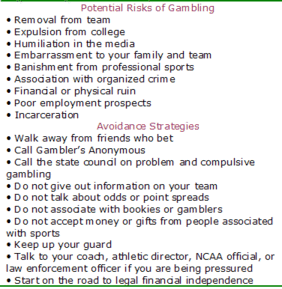The WAGER Vol. 7(18) – Don’t Bet On It: Curtailing Gambling Among Student-Athletes
Despite being banned by the National College Athletic Association (NCAA), sports betting among college athletes occurs with surprising frequency (WAGER 7(10)). In an effort to prevent or at
least minimize the amount of gambling that occurs on college campuses, the NCAA together with the National Endowment for Financial Education (NEFE) developed an online self-help guide, “Don’t bet on it: Don’t gamble on your future,” (National Endowment for Financial Education & National College Athletic Association, 1999).
The guide presents anecdotal evidence about students who suffered negative consequences of sports betting, information about the risks of on-campus betting, NCAA rules pertaining to gambling, financial success strategies, and a list of ways to stay out of gambling. Table 1 summarizes some risks and avoidance strategies reported in “Don’t bet on it…”
Table 1: Summary of Gambling Risks and Avoidance Strategies noted by the NCAA
The NCAA and NEFE should be commended for attempting to prevent a potentially serious problem for student athletes. Research suggests that athletes frequently hold attitudes that could ultimately place them at risk for gambling (Cross, Basten, Hendrick, Kristofic, & Schaffer, 1998; National Endowment for Financial Education & National College Athletic Association, 1999). More attention to student athletes is needed.
However, the means with which the risk factors and avoidance strategies were derived by the NCAA were not given and we therefore do not know whether the factors and strategies were empirically generated. Consequently, the validity of the factors that comprise this on-line self-help guide is uncertain. Similarly, it is not clear whether these factors are comprehensive; more dimensions of risk and avoidance may be necessary to make prevention possible. In addition, the brochure tends to focus on things that one should not do (e.g. don’t hang out with bookies) rather than suggesting healthy ways that student athletes can behave, thereby diverting urges to engage in risky behaviors. At times the brochure seems like a stern lecture. This strategy risks inadvertently stimulating resistance from students. Finally, “Don’t bet on it…” provides extensive financial planning strategies that are likely intended to assuage urges to make money by gambling. However, it is unclear if making money is a major reason that college students gamble, or if college students would respond favorably to financial self-help strategies.
Developing an on-line resource for student athletes represents a creative and potentially important tool for limiting gambling and its adverse sequelae. However, much more research on student athletes themselves is needed to determine the best way to reach this unique population. It is essential to evaluate the impact of this resource scientifically to assure that—as the first principle of medical ethics suggests—this resource should “do no harm.”
Comments on this article can be addressed to Debi LaPlante.
References
Cross, M. E., Basten, J., Hendrick, E. M., Kristofic, B., & Schaffer, E.
J. (1998). Student-athletes and gambling: An analysis of attitudes towards risk-taking. Journal of Gambling Studies, 14(4), 431-439.
National Endowment for Financial Education, & National College Athletic Association. (1999). Don’t bet on it: Don’t gamble on your future. Retrieved April 29, 2002, from the World Wide Web: http://www.ncaa.org/gambling/dontbetonit/congrats2.html
